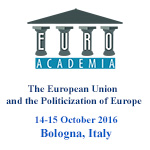Euroacademia Conferences
 Europe Inside-Out: Europe and Europeanness Exposed to Plural Observers (9th Edition) April 24 - 25, 2020
Europe Inside-Out: Europe and Europeanness Exposed to Plural Observers (9th Edition) April 24 - 25, 2020 Identities and Identifications: Politicized Uses of Collective Identities (9th Edition) June 12 - 13, 2020
Identities and Identifications: Politicized Uses of Collective Identities (9th Edition) June 12 - 13, 2020 8th Forum of Critical Studies: Asking Big Questions Again January 24 - 25, 2020
8th Forum of Critical Studies: Asking Big Questions Again January 24 - 25, 2020 Re-Inventing Eastern Europe (7th Edition) December 13 - 14, 2019
Re-Inventing Eastern Europe (7th Edition) December 13 - 14, 2019 The European Union and the Politicization of Europe (8th Edition) October 25 - 26, 2019
The European Union and the Politicization of Europe (8th Edition) October 25 - 26, 2019 Identities and Identifications: Politicized Uses of Collective Identities (8th Edition) June 28 - 29, 2019
Identities and Identifications: Politicized Uses of Collective Identities (8th Edition) June 28 - 29, 2019 The European Union and the Politicization of Europe (7th Edition) January 25 - 26, 2019
The European Union and the Politicization of Europe (7th Edition) January 25 - 26, 2019 7th Forum of Critical Studies: Asking Big Questions Again November 23 - 24, 2018
7th Forum of Critical Studies: Asking Big Questions Again November 23 - 24, 2018 Europe Inside-Out: Europe and Europeanness Exposed to Plural Observers (8th Edition) September 28 - 30, 2018
Europe Inside-Out: Europe and Europeanness Exposed to Plural Observers (8th Edition) September 28 - 30, 2018 Identities and Identifications: Politicized Uses of Collective Identities (7th Edition) June 14 - 15, 2018
Identities and Identifications: Politicized Uses of Collective Identities (7th Edition) June 14 - 15, 2018
Bologna’s Iconography. The Representation of the City in the Paintings of Pinacoteca Nazionale
-
-

-
Presentation speakers
- Denise Tamborrino, Polo Museale dell'Emilia-Romagna, Italy
Abstract:
Between the fourteenth and seventeenth centuries, in Bologna, there were already present different architectures, which have become significant for its urban landscape, and that have influenced its development over the centuries. In the historical chronicles, however, the representation of Bologna always related to adjectives such as “scholarly” and “fat”, which could be hardly represented; in the literary sources, it is not present the identification of an architectural element that can symbolize the city as a whole. In general, the appearance of the city exerts a significant influence on the images the painters re-propose it during different historical periods: the real urban configuration is not binding for its representation. The artist did not start from the visual impression of the real urban structure, but from an idea, a concept. So, the representation of the city begun as a conceptual representation of a balance between economic, political and architectural meanings, subtended to its operational functions. Perceived city and real city are two artistically distinct concepts that do not always identify themselves in a unique representation, due to the architectural presence. Analyzing the paintings inside the Pinacoteca Nazionale di Bologna, this paper wants to focus on how and why the representation of the city of Bologna differs from the real urban landscape between the fourteenth and the seventeenth century, despite the presence of the great architectures that have profoundly marked the face of the city as well as still perceived.
-
Related Presentations













